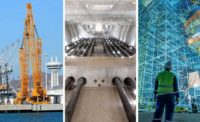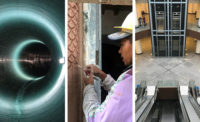The 3.9-m-long, 1.1-m-wide skis, sourced in Germany, double as spreader foundations. "They are very precisely designed with a slight [V-shape] on the underside" and rounded in front, to minimize frictional resistance when moving the 60-tonne to 200-tonne modules, Wright says.
A slot was built into the skis to insert a daggerboard in case the modules began to slide under heavy wind loads. “In actual fact, it hasn’t proved necessary to have those centerboards installed, because you get such a strong bond between the ice surface and the underside of the ski that the module stays firmly fixed in position,” says architect Hugh Broughton.
The base may not need to be moved for many years, but the procedure already has been tested successfully. The base was built next to Halley V to provide workers with accommodations during construction and then, after completion, towed about 10 miles to its new home. Halley VI's design life is 20 years, but its mobility and modular design could keep it in service 40 years or more, says Caroline Lewis, BAS logistics coordinator.
Each module's steel space-frame substructure helps combat stresses during movement. The steel superstructure attaches to the perimeter to maximize flexibility of interior spaces. Specially manufactured, high-ductility steel prevents brittle fractures in the cold climate. Blue modules measure 19 m long by 9.5 m wide, while the red module is 28 m long by 11.5 m wide.
Construction crews had a 10- to 12-week window to build on-site each year, due to dangerous weather conditions and accessibility issues. “It’s a difficult place to transport people to; it’s expensive, and once they get there its expensive to keep them alive, so you want to minimize the number of people on the ice,” Hammerton Says. "If we could have pre-engineered and manufactured [entire modules] outside of Antarctica, that would have been the ideal solution."
However, the idiosyncrasies of the Antarctic supply line stymied delivery of fully assembled modules. Icebreaker ships off-load cargo onto sea ice that forms each winter, usually 1 m thick. "We made it clear from the outset that there were severe restrictions on weight, and the designers were required to incorporate this into their designs," Lewis says.
Crossing the sea ice, each load could not exceed six tonnes—plus 3.5 tonnes for the sledge—or else crews risked breaking through the ice. Despite this limitation, Galliford Try maximized the modular, pre-engineered components by pre-assembling as much as possible in Cape Town, South Africa, while keeping each chunk below the weight limit.
Bedrooms, bathrooms, generators and control panels were configured and delivered in preassembled pods. Flooring and under-floor building systems were delivered in "cassettes" that were easily installed.
Crews performed on-site assembly using two lightweight Mantis 6010 30-ton crawler cranes. "[The cranes] could just do the maximum lift that we needed, and it was easy to separate the jib and the counterbalance off for transport across the sea ice but very quick and easy to put back together again," Hammerton says.
With such a short build season, all the preassembled components had to fit right the first time. To reduce risk of on-site problems, the project team test-erected steel and cladding for two modules in South Africa. It turned out one of the pieces didn't fit correctly on the red module, but "we could just take it back to the workshop down the road and fix it," Ayres says. "If that had happened in Antarctica, we'd have lost a year."
Upon completion in February 2013, the contractor had performed 250,000 worker hours without a recordable incident. "The implications of having an accident [in Antarctica] are far more serious than they would be elsewhere," Hammerton says. The spotless record was attained through meticulous planning, managing risks and fostering a spirit of teamwork and camaraderie among the workers, he adds. Workers were schooled on unusual hazards, such as snow blindness and whiteout conditions.












Post a comment to this article
Report Abusive Comment